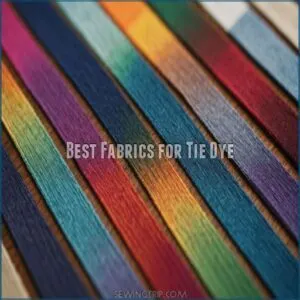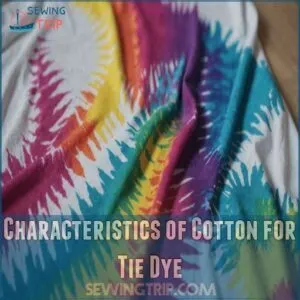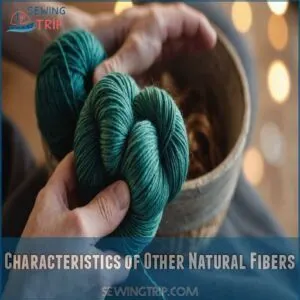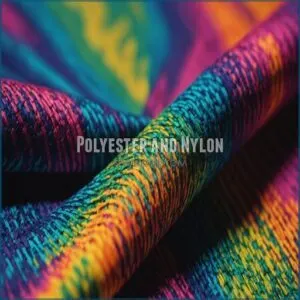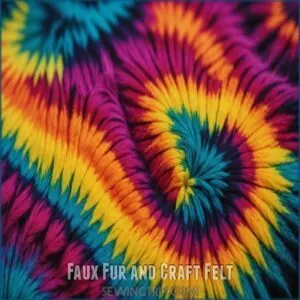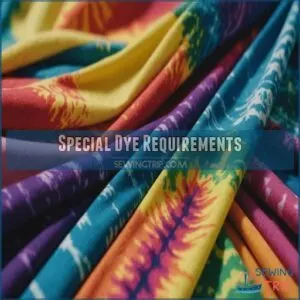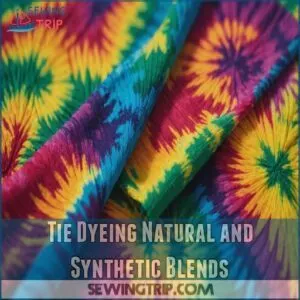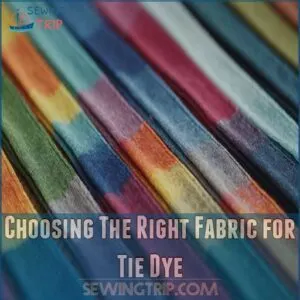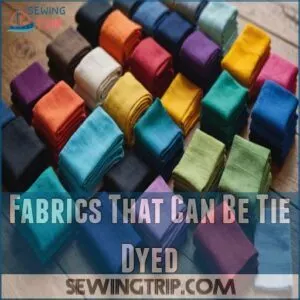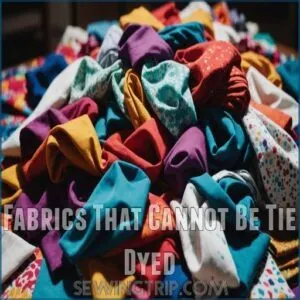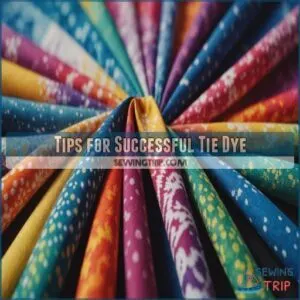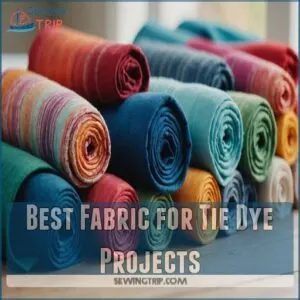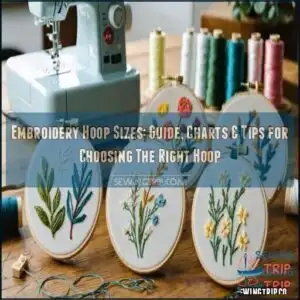This site is supported by our readers. We may earn a commission, at no cost to you, if you purchase through links.
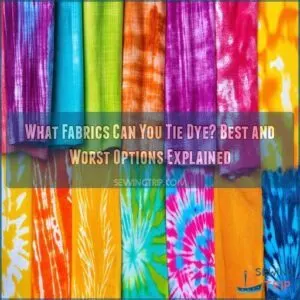 When you’re ready to explore the vibrant world of tie dye, reaching for natural fibers is your best bet.
When you’re ready to explore the vibrant world of tie dye, reaching for natural fibers is your best bet.
Cotton steals the spotlight with its superb dye absorption and variety in textures.
Linen and bamboo join the party, offering a cool touch and sustainable flair.
You might also enjoy the durability of hemp or the luxurious sheen of silk.
However, steer clear of 100% polyester or fanciful faux fur—they’re like rain on your colorful parade!
For a twist, try cotton-poly blends, but remember, their colorfastness can be unpredictable.
Ready for more tie dye magic? Stay tuned for extra tips!
Table Of Contents
- Key Takeaways
- Best Fabrics for Tie Dye
- Characteristics of Cotton for Tie Dye
- Characteristics of Other Natural Fibers
- Synthetic Fibers for Tie Dye
- Tie Dyeing Natural and Synthetic Blends
- Choosing The Right Fabric for Tie Dye
- Fabrics That Can Be Tie Dyed
- Fabrics That Cannot Be Tie Dyed
- Tips for Successful Tie Dye
- Best Fabric for Tie Dye Projects
- Frequently Asked Questions (FAQs)
- Conclusion
Key Takeaways
- You’ll achieve the best tie-dye results with natural fibers like cotton, silk, and rayon because they absorb dye beautifully and produce vibrant colors.
- Avoid using polyester, faux fur, or craft felt for tie-dye projects; they don’t hold dye well, resulting in dull or patchy colors.
- Cotton-polyester blends are possible to tie-dye, but the polyester will reduce color intensity; try using a color intensifier for richer hues.
- For eco-friendly tie-dye, choose fabrics like bamboo and hemp, as they not only absorb dye well but are also sustainable options.
Best Fabrics for Tie Dye
When you’re looking to achieve the most vibrant and long-lasting tie-dye results, cotton, rayon, and silk are your best bets.
These fabrics, thanks to their natural fibers and ability to absorb dye effectively, offer you a colorful canvas to express your creativity.
Natural Fibers
For tie dye, natural fibers really steal the show.
Other fabrics like Merino wool, known for its exceptional moisture-wicking properties, also hold potential for creative dyeing. Cotton, with its Natural Fiber Properties, becomes a canvas that absorbs vibrant colors like magic.
Linen and silk, known for lasting pigment, add texture to tie dye projects.
You’ll love hemp for its sustainability and softness over time.
Mastering Tie Dyeing Techniques on these fibers gives your designs a colorful, eco-friendly edge, offering freedom to express creativity fully.
Synthetic Fibers
You might think when comparing polyester vs rayon for tie-dye projects, polyester vs rayon can help you decide, but the fact is synthetic fibers like polyester and nylon can’t join the tie-dye party, but with the right techniques, they can.
These fabrics, similar to those used in cross stitch, like aida fabric for beginners, need special dyes, known as disperse dyes, to work their magic.
Colorfastness and durability may take a hit, so choose wisely.
Tri-blend shirts, featuring cotton, poly, and rayon, can surprise you with interesting results, though pure synthetics often need an innovative touch for vivid tie-dye designs.
Blends of Natural and Synthetic Fibers
Although blending natural and synthetic fibers can create unique textures, these fabrics present their own dye challenges.
To get the best results, make sure you have the right tie dye supplies online.
A high natural fiber content ensures vibrant results, so consider these essentials:
- Dye absorption may be limited, affecting color richness.
- Colorfastness might vary, leading to uneven wear.
- Blending ratios influence durability and dye uptake.
- Washing tips are important to maintaining vibrancy.
- Craft felt often resists dye, avoid it for best results.
Characteristics of Cotton for Tie Dye
When you’re choosing fabric for tie dye, cotton is your best friend because of its incredible ability to absorb dye and create vibrant colors.
Cotton is the go-to choice for so many tie-dye enthusiasts!
With a wide range of weaves available, it’s no wonder why.
Absorbs Dye Well
Cotton’s stellar dye absorption makes it a tie-dye champion.
Its porous nature allows for deep color penetration, resulting in vibrant, long-lasting hues.
Dye absorption factors like fabric porosity directly impact color intensity.
Different dye types work beautifully with cotton, offering a wide range of tie dye techniques.
You’ll achieve richly saturated colors, making your designs pop.
Experimenting with dye types and techniques opens up creative possibilities.
Cotton’s absorbency is key to successful tie-dyeing.
Available in Many Weaves
In the world of cotton for tie dye, its varying weaves add exciting possibilities.
From the tightness of the weave to its overall texture, each type provides unique characteristics that influence the dye patterns and colors you’ll achieve.
For instance, a satin-like weave fabric can create a beautiful, luxurious design.
Imagine tie dyeing a fresh cotton weave and watching vibrant colors come to life.
Consider these aspects:
- Cotton weaves affect dye absorption.
- Fabric textures result in varied designs.
- Weave types, including those with loose rayon weaves, impact fabric weight and drape.
Most Common Tie Dye Fabric
Exploration of cotton weaves takes you to understanding its popularity for tie dye.
Cotton fabric qualities make it a rock star in the tie dye world, taking color like a charm.
Compared to rayon, it’s less finicky and simple to care for.
Whether you’re crafting the best cotton for shirts or exploring cotton blend tie dye, cotton’s versatility is unmatched.
| Cotton Type | Absorbency | Versatility |
|---|---|---|
| Muslin | High | Very |
| Jersey | Medium | Moderate |
| Canvas | Low | Limited |
Characteristics of Other Natural Fibers
When you explore tie dye, don’t overlook other natural fibers like rayon, linen, hemp, and bamboo, each bringing its own unique flair to your creations.
Rayon is incredibly absorbent, linen offers a natural touch, hemp is durable and softens over time, and bamboo is both natural and sustainable.
Rayon Very Absorbent
Rayon’s magic lies in its uncanny ability to absorb dye like a sponge. You’ll find it perfect for tie-dyeing, with colors popping vibrantly.
Just remember these key points:
- Use gentle washing to preserve hues.
- Utilize cool water, minimizing wear.
- Contrast with cotton, noting rayon’s shine.
- Apply careful techniques to prevent fraying.
Rayon promises vivid, lasting designs.
Linen Natural Fiber
Imagine turning a plain linen fabric into a vibrant masterpiece.
Linen’s texture, with its cool yet absorbent nature, makes it perfect for tie dye experiments.
Meanwhile, don’t sweat the wrinkles; they add character.
Embrace the process—linen’s history spans centuries.
For vibrant results: iron before starting.
Here’s a quick guide:
| Property | Description | Tip |
|---|---|---|
| Texture | Smooth and cool | Embrace the wrinkles |
| Absorption | Excellent for tie dye | Iron before starting |
| Durability | Very strong | Long-lasting designs |
| Nature | Natural fiber from flax | Sustainable choice |
| History | Used for centuries | Adds rich character |
Hemp Durable and Softens Over Time
Just like linen, hemp offers a natural vibe with its impressive durability.
It softens over time, making your dyed garments more comfortable with every wash, but it’s also a sustainable choice for eco-conscious creators.
When you’re eyeing hemp for tie-dye projects, consider its:
- Rugged texture
- Excellent dye absorption
- Longevity with wear
- Easy care instructions
Bamboo Natural and Sustainable
Two key aspects make bamboo a fantastic choice for eco-friendly dyeing: its sustainability and absorbency.
You’ll find it readily accepts dyes, creating vibrant colors.
Proper bamboo fabric care is essential.
| Property | Advantage | Consideration |
|---|---|---|
| Sustainability | Renewable resource, less environmental impact | Sourcing ethically is very important |
| Dye Absorption | Takes dye beautifully, vibrant results | Pre-wash to remove sizing for the best results |
| Texture | Soft and smooth | May require careful handling during tie-dyeing |
Synthetic Fibers for Tie Dye
When you’re looking to tie dye synthetic fibers, which are often bleach-resistant fabrics, you might feel like you’re up against a bit of a challenge, but don’t worry too much.
Fabrics like polyester and nylon require specific dyeing techniques to keep the colors from fading faster than a popsicle on a hot day.
Polyester and Nylon
After exploring natural fibers, let’s chat about polyester and nylon.
While they’re known for their resilience, dyeing them isn’t straightforward.
Polyester resists typical dyeing techniques unless using dispersible dyes or boiling water, which may test your patience.
Nylon’s a bit friendlier, absorbing acid dyes with surprising ease.
So, if you have synthetic favorites, don’t fret — they can still pop with color using the right approach!
Faux Fur and Craft Felt
Tie-dyeing polyester, while tricky, leads us to a conundrum with faux fur and craft felt.
These synthetic options present significant tie dye challenges, as they’re typically made from completely synthetic fibers like nylon and polyester.
Faux fur struggles with dye absorption problems, often leaving colors dull and fading fast.
Craft felt limitations don’t help either; it loses color and alters texture quickly.
Consider alternatives to faux fur if you’re seeking vibrant results. You’ll find natural fibers like cotton or rayon a more rewarding choice.
Special Dye Requirements
Shifting from faux fur’s challenges, synthetics hold their own mysteries.
Polyester and nylon require special attention to dyes.
Regular colors won’t cut it; instead, reach for disperse dyes or acid dyes to achieve vibrant hues.
Fiber reactive dyes don’t stick well here.
To make those bold patterns pop, you’ll need dye fixatives.
It’s like trying to paint on glass, fun yet demanding, and very rewarding when you get it right!
Tie Dyeing Natural and Synthetic Blends
When you’re tie-dyeing fabric blends like cotton-polyester or tri-blends, you might notice they don’t hold color as well as 100% natural fibers.
These blends can result in a cool two-tone effect, but be prepared for some color to wash out, adding a touch of unpredictability to your project.
Cotton Polyester Blends
Moving from synthetic to natural blends, cotton-polyester blends offer unique challenges and opportunities in tie-dyeing.
These blends can trick you, as polyester isn’t a fan of dye.
To make the most of them, consider:
- Dye Absorption: Opt for a cotton-rich blend for better color uptake.
- Color Vibrancy: Use color intensifiers to boost hues.
- Fabric Quality: Wash carefully to maintain vibrancy without compromising fabric integrity.
Tri Blends for Tie Dye
Tri-blend fabrics, often a mix of cotton, polyester, and rayon, present unique opportunities for tie-dye enthusiasts.
You’ll find that tri-blend dye results are surprisingly vibrant, though color intensity might be slightly less than with 100% cotton.
Tri-blend tie dye techniques are similar to those used for cotton, but remember proper tri-blend fabric care is essential for long-lasting results.
For tri-blend shirt recommendations, look for blends with a higher cotton percentage.
Experiment and express your creativity!
Challenges and Considerations
Alright, when balancing natural and synthetic fibers, you’ve got a colorful puzzle to solve.
Dye absorption can vary, making color fastness the name of the game.
Synthetic blends might shrink less, but watch out—they’re finicky, often leading to color fading.
Dye safety matters too, so always check labels!
Remember, washing techniques play a big role in your success, ensuring your masterpiece doesn’t disappear down the drain.
Choosing The Right Fabric for Tie Dye
Choosing the right fabric for tie dye can make or break your design, as some materials soak up color like a sponge while others leave you feeling like you’ve tried tie-dyeing your cat.
Natural fibers like cotton and silk are the best choices for the most vibrant results.
Don’t shy away from experimenting with blends to discover unique color effects.
Considerations for Natural Fibers
Choosing natural fibers for tie dyeing is like picking the right canvas for a masterpiece.
Cotton, in particular, is an excellent choice due to its natural softness and breathability, which allows for superior comfort and absorbency.
Linen and hemp also absorb dye beautifully, giving you vibrant colors and rich textures.
These fabrics boast durability, meaning your creations stay stunning wash after wash.
Remember care instructions: a gentle wash keeps patterns bright and bold.
Natural fibers are your ticket to tie dye glory, crafting wearable art with every twist and bind!
Considerations for Synthetic Fibers
Natural fibers absorb dye like a sponge, but when you consider synthetics, it’s a whole different ball game.
You can find a variety of tie dye blanks online, such as those on Every Simply, to test your skills.
Polyester and nylon often need specialty dyes to stick and guarantee colorfastness.
You might use a color intensifier to enhance brightness, but don’t expect miracles.
Limitations arise with faux fur or craft felt, which stubbornly resist vibrant hues.
Remember, synthetic fabrics require special techniques to achieve lasting colors.
Blends and Their Suitability
Blends and Their Suitability (Choosing The Right Fabric for Tie Dye)
Shifting gears from synthetic fibers, let’s chat about blends.
If you love mixing fibers, you’re in for a nuanced adventure.
Blend ratios like 50-50 cotton-polyester affect dye absorption and colorfastness.
Expect more subdued hues and keep durability in mind, especially for frequent washing.
For a broader selection of fabrics suitable for tie-dye, check out tie dye fabric products.
Tri-blends with rayon offer creativity, but remember, synthetic fibers wash out quicker than cotton.
Know your fabric’s secrets for a lasting tie-dye masterpiece!
Fabrics That Can Be Tie Dyed
When you’re ready to transform plain fabrics into colorful works of art, choosing the right materials is key.
Cotton, denim, silk, rayon, bamboo, and hemp all soak up dyes beautifully, making them perfect candidates for your tie-dye projects.
Cotton and Denim
So, you’ve picked your perfect tie-dye project? Great! Let’s talk cotton and denim.
Cotton’s a classic, readily absorbing dye for vibrant results.
To achieve the best results, make sure to preparing cotton for dyeing, as it will guarantee your fabric is fully saturated and even.
Denim, being cotton, works similarly, though its tighter weave might mean you need more dye for deep colors.
Experiment with different tie-dye techniques to achieve unique color variations.
Remember those washing tips to keep your creations looking fresh!
Denim projects, like custom jackets, are super popular. Have fun expressing yourself!
Silk and Rayon
Ah, the elegance of silk and rayon! Both invite color vibrancy with open arms, offering stunning results if you pick the right dyeing techniques.
Picture yourself crafting:
- Luxurious silk scarves
- Vibrant rayon tops
- Intricate tie-dye wall hangings
- Quality fashion accessories
- Playful home decor
Silk, with its luminous sheen, enhances every hue.
Rayon, though less durable, offers a fantastic palette for your most vivid project ideas. Just mind the care—gentle handling keeps these beauties brilliant!
Bamboo and Hemp
While silk and rayon add elegance to tie dye fabrics, bamboo and hemp bring sustainability to the table.
Bamboo tie dye embraces nature with its natural dyes, producing vibrant patterns.
Hemp fabric, known for strength, softens with wear, making it a great choice for eco-friendly fashion.
You can experiment with fabric scraps to see how these sustainable options accept dye, creating unique, long-lasting designs that speak to your creativity.
Fabrics That Cannot Be Tie Dyed
When you’re picking fabrics for tie dye projects, steer clear of polyester and faux fur because they don’t absorb dye well and colors just wash away.
Synthetic blends and craft felt are also troublemakers since they end up looking patchy and dull, challenging your artistic visions.
Polyester and Faux Fur
When you’re dreaming of vibrant tie-dye wonders, polyester and faux fur present dyeing challenges.
These synthetic fabrics don’t absorb dye well, leading to dull results and colorfastness issues.
Faux fur adds an extra hurdle; its thick, fluffy nature resists tie-dye techniques.
Instead, explore alternatives to faux fur for bold, lasting colors.
Remember, finding the right dye types for synthetics is key to overcoming synthetic limitations and achieving your creative vision.
Craft Felt and Synthetic Blends
Craft felt and synthetic blends aren’t your best friends for tie dye adventures. Their dye absorption is like trying to fill a sieve—frustrating and often fruitless.
The colors wash out easily, lacking any kind of reliable colorfastness.
If you’re aiming for vibrant hues, look elsewhere or try alternative materials.
Synthetic fibers in blends resist dye, leading to patchy, faded results that make your effort feel more like a comedy of errors than a creative triumph.
Challenges and Limitations
Tired of wrestling with craft felt’s trickiness?
Let’s chat about fabrics that refuse to play nice with dye.
Polyester‘s a color-washout king, leaving you frustrated instead of fabulous.
Faux fur‘s another flop, more fluff than fashion.
Even sheer polyester struggles, with colors running away faster than your patience.
Synthetic blends? They add washing woes, making you second guess your choices.
Stick with fibers that embrace color, not shrug it off.
Tips for Successful Tie Dye
Ready to create amazing tie-dye masterpieces? These simple tips will help you achieve vibrant, long-lasting colors, ensuring your tie-dye projects turn out exactly as you envision.
Soak Fabric Before Dyeing
Ever wondered why soaking your fabric before tie dyeing is a smart move?
Think of it as giving your fabric a relaxing spa day.
Soaking time varies, but typically, 30 minutes in lukewarm water does the trick.
Use plain water or mix in a soaking solution for better results.
Before you start soaking, consider pre-washing your fabric to prevent shrinkage and color bleeding, especially for natural fibers like cotton, linen, and silk, which can greatly benefit from a pre-wash as explained in the pre-wash different fabrics guide.
This step helps even color absorption, making your tie-dye masterpiece not just vibrant but also more durable.
Happy dyeing!
Use Soda Ash Fixative
After soaking your fabric, grab some soda ash for a vibrant tie-dye outcome.
It’s like giving your colors a superpower!
Known for enhancing colorfastness, soda ash preps your fabric, allowing dye to cling better.
Safer than it sounds, using proper gloves keeps you worry-free.
If soda ash isn’t your thing, fixative alternatives exist.
Remember, mastering fixative application helps maintain your fabric’s dazzling hues without dulling your creative spirit!
Heat Set Dyed Fabric
While soda ash sets the stage for your tie dye masterpiece, the next step is equally as important: heat setting your dyed fabric.
Doing so guarantees colorfastness and minimizes fabric shrinkage.
Utilize a reliable heat source, like an iron or dryer, and pay attention to heat setting time specific to your dye type.
A hot, brief press seals in colors almost magically, extending the life of your vibrant art pieces.
Craft confidently!
Best Fabric for Tie Dye Projects
When you’re choosing fabrics for your tie-dye project, it’s important to pick materials that absorb dye well, like cotton or silk, to guarantee vibrant results.
A successful project often starts with selecting the right fabric, so consider each fabric’s characteristics and your project’s needs for the best results.
Considerations for Different Projects
Choosing the right fabric for your tie dye project depends on factors like fabric weight and design complexity.
Cotton is a popular choice for vibrant tie dye tapestries, while silk offers elegance for intricate designs.
Remember, colorfastness and dye types matter—different fabrics need specific dyes.
So, whether you’re crafting a bold tapestry or delicate scarf, experiment with fabric scraps to find your ideal match.
Embrace creativity; let your designs shine!
Choosing The Right Fabric
Fabric Durability and Dye Absorption hold the key to stellar tie dye results.
Think about what your finished project needs, and don’t let Fabric Weight throw you off!
You’re aiming for vibrancy and longevity, so consider these stellar options:
- Cotton: Versatile and easy to work with.
- Silk: It’s known for its smooth, soft, sensuous texture and natural glide, often described as having a liquid-smooth silky feel. Luxurious feel and striking colors.
- Hemp: Strong, yet softens over time.
- Rayon: Bright, bold, and beautiful when done right.
Tips for Success
Many tie-dye newbies wonder which fabrics work best.
For vibrant results, choose 100% cotton; it’s absorbent and readily available.
Pre-wash your fabric to remove sizing, ensuring even dye absorption.
Proper fabric prep is key for dye application and achieving those awesome tie-dye patterns.
Remember dye safety precautions—always wear gloves!
Experiment with color blending for unique shades.
Have fun expressing your creativity!
Frequently Asked Questions (FAQs)
What fabrics can be tie dyed?
You know the saying, "Variety is the spice of life."
Cotton, silk, rayon, and hemp are perfect for tie dyeing.
These fabrics soak up dyes beautifully, giving you vibrant colors and endless possibilities for unique designs.
What materials are needed for tie-dying?
Grab some white cotton fabric, vibrant dyes, rubber bands, gloves, and plastic wrap.
Add buckets for mixing, a rack for drying, and a splash of creativity.
Voilà, you’re set for a colorful tie-dye adventure!
What is the best dye for tie-dye?
Imagine transforming a plain shirt into a vibrant masterpiece.
Use fiber-reactive dyes for cotton or natural fabrics; they bond chemically, ensuring striking colors that last.
Don’t underestimate their power to revive your creative spirit.
What fabrics can you use to dye clothes?
When choosing fabrics for dyeing clothes, opt for cotton, rayon, linen, hemp, and silk.
These materials absorb dye beautifully, ensuring vibrant, long-lasting colors.
Avoid polyester and synthetic blends, as they don’t hold dyes well.
What fabrics cannot be tie-dyed?
You can’t tie-dye polyester, faux fur, or felt; the dyes won’t stick. Synthetic blends are tricky, too. Natural fibers like cotton and silk are your best bets for vibrant results.
What fabrics can be used for tie-dye?
Did you know over 70% of tie-dyers prefer cotton?
It’s super absorbent and affordable.
You can also use rayon, silk, and hemp for vibrant results because they’ve got the knack for soaking up colors brilliantly.
Can I tie-dye 50 cotton 50 polyester?
Yes, you can tie-dye 50% cotton, 50% polyester fabric, but don’t expect vibrant results.
The cotton absorbs dye well, providing color contrast, while polyester doesn’t hold dye effectively.
Try using a color intensifier for better outcomes.
Can you tie-dye 60% cotton 40% polyester?
Tie-dying 60% cotton and 40% polyester is possible, but results won’t be as vibrant as with 100% cotton.
The polyester resists dye, leading to muted colors.
Use a color intensifier to enhance vibrancy if desired.
How do fabric blends affect tie dye results?
Fabric blends like cotton-polyester affect tie-dye by reducing dye absorption.
You’ll see muted colors and less vibrant patterns.
For bold results, stick with natural fibers like cotton, or use a color intensifier to enhance dyes.
What pre-treatments improve dye absorption in fabrics?
Boost dye absorption by pre-soaking fabrics in a soda ash solution.
This helps the colors pop, making them more vivid and lasting.
Make sure you’re using natural fibers; they soak up the dye better, avoiding any muted results.
Can tie dye techniques be used on knits?
Yes, you can! Knit fabrics, especially cotton knits, work well. Just be gentle; they’re stretchy. Pre-wash to avoid shrinkage surprises. Have fun experimenting!
How does fabric weight impact tie dye design?
When you’re tie-dyeing, fabric weight plays a big role.
Heavier fabrics absorb more dye, giving you rich colors, while lighter ones might spread the dye faster, creating softer patterns.
Experiment to find your perfect balance!
Are natural dyes effective for tie dye projects?
Did you know that 80% of natural dyes come from plants?
They’re fantastic for tie-dyeing natural fabrics, offering vibrant, eco-friendly colors.
Just remember, these dyes need mordants to bind color to the fabric, ensuring longevity.
Conclusion
Starting your tie dye adventure is like opening a portal to endless creativity, especially when you know what fabrics can you tie dye.
Stick with natural fibers like cotton and linen for vibrant hues that pop.
Be cautious with synthetic blends, as their results can be unpredictable.
Understanding fabric properties helps you choose wisely, making your tie dye experiences joyful and successful.
So, grab your favorite fiber, let your dyes flow, and let your inner artist shine!

